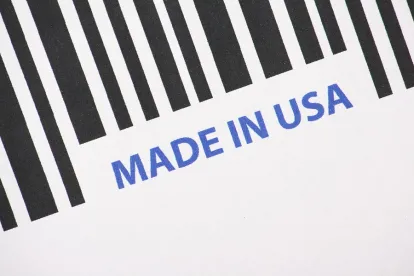The Trump Administration’s trade dispute with China widened this week when the Office of the U.S. Trade Representative (USTR) released a proposed list of Chinese products valued at $200 billion that would be subject to an additional 10% ad valorem duty. USTR’s proposed tariffs cover both consumer and industrial products falling under 6,031 tariff subheadings. This action carries out President Trump’s promise of more tariffs in response to China’s retaliation against the initial round of tariffs imposed under Section 301 of the Trade Act of 1974. In it notice of proposed tariffs, USTR set out a schedule for public comment and hearings ending on August 30.
The initial round of tariffs imposed a 25% ad valorem duty on 818 tariff subheadings that became effective on July 6, with an approximate annual trade value of $34 billion. That notice further proposed the same 25% duty on Chinese products classified in 284 tariff subheadings, with an annual trade value of approximately $16 billion. The selected tariff headings focused on industrially significant technology, including technologies and products related to China’s “Made in China 2025” industrial policy program. Notice of this action was published in the Federal Register on June 20, 2018.
Coinciding with the imposition of the first phase of tariffs on July 6, USTR announced procedures for requesting product exclusions from the additional 25% ad valorem tariff.
Interested Parties Need to Act Promptly
The tariffs proposed by USTR are now open for public comment, but the time to respond is short. Requests for product exclusions must be filed no later than October 9, 2018.
Written comments on the 284 tariff subheadings proposed for 25% duties must be submitted by July 23, 2018. A public hearing will be held on July 24, 2018. Requests to appear at the public hearing were required to be submitted by June 29, 2018. Post-hearing rebuttal comments will be due on July 31, 2018.
Written comments on the latest round of 6,031 tariff subheadings proposed for 10% duties must be submitted by August 17, 2018 to be assured of consideration. Public hearings will be held on August 20-23, 2018 and requests to appear at the public hearing must be submitted by July 27, 2018. Post-hearing rebuttal comments will be due on August 30, 2018.
With respect to the latest round of proposed tariffs, USTR invites comments with respect to any aspect of the proposed action, including:
- The specific tariff subheadings to be subject to increased duties, including whether any listed subheadings should be retained or removed, or whether subheadings not currently on the list should be added.
- The level of the increase, if any, in the rate of duty.
- The appropriate aggregate level of trade to be covered by additional duties.
In both of its requests for comment, USTR has asked commenters to address specifically whether imposing duties on a particular subheading would be practicable or effective to obtain the elimination of China’s acts, policies and practices related to technology transfer, intellectual property and innovation, and whether maintaining or imposing additional duties on a particular product would cause disproportionate economic harm to U.S. interests, including small or medium size businesses and consumers.
Decisions by USTR on the final list of products subject to the tariffs are expected after consideration of the comments received and hearing testimony. Affected parties should consider providing comments to USTR. Submission of comments can be effective in reducing the scope of the proposed tariffs. After consideration of comments in its initial review, USTR removed 515 tariff subheadings from the initial list of 1,333 proposed to be subject to the first phase of Section 301 tariffs.
Interested persons wishing to seek a product exclusion will need to act promptly to meet the October 9, 2018 deadline for submission of requests that comply with the specific procedures and criteria set out by USTR. Requests will be open for response within 14 days after the request is posted in USTR’s docket number USTR-2018-0025 at www.regulations.gov. Replies to responses will be due 7 days after the close of the 14-day response period. USTR published the exclusion procedures in the Federal Register on July 11, 2018.
Steps to Take Now
Faced with looming deadlines for comments and exclusion requests, what steps should importers be taking now?
- Review the tariff classifications of products imported from China
The current and proposed Section 301 tariffs are all based on the tariff classification of the imported product. Classification often does not receive the attention that it deserves, especially if the classification is duty free. Now is the time to confirm that your current classifications are correct.
- Review the country of origin of products imported from China
The Section 301 tariffs will be applied only to goods falling under a designated tariff classification with China as the country of origin. Determining the origin of a product can involve a complex analysis if the product incorporates inputs from countries other than China. If key components or materials are sourced outside China and are subject only to minor processing or assembly in China, there may be a basis to claim a country of origin other than China. Review of the bill of material for the product detailing the country of origin for each of its inputs should facilitate this analysis.
- Consider alternative sourcing and production options
Because the Section 301 tariffs affect only goods of Chinese origin, sourcing the product in another country would avoid the effect of the tariffs. Alternatively, consider whether components and materials with Chinese origin can be sent to another country where the finished product would be produced. If the process in the other country results in a substantial transformation of the Chinese components and materials, there may be a basis to designate that country as the country of origin. Note that while a change in the tariff classification of the Chinese components after incorporation into the finished product would be one factor to consider, it is not decisive. This is a complex question and should be considered very carefully.
- Prepare a product exclusion request
If, after consideration of the points discussed above, the product will be subject to Section 301 tariffs, relief may be available by filing a request for a product exclusion with USTR. Considering that the products selected for inclusion will be determined following a public comment and hearing process, requests for exclusion will need to focus on the following factors that USTR identified as relevant to the rationale for exclusion (i.e., whether the particular product is available only from China; whether the imposition of additional duties on the particular product would cause severe economic harm to the requester or other U.S. interests; and whether the particular product is strategically important or related to “Made in China 2025” or other Chinese industrial programs).




 />i
/>i
